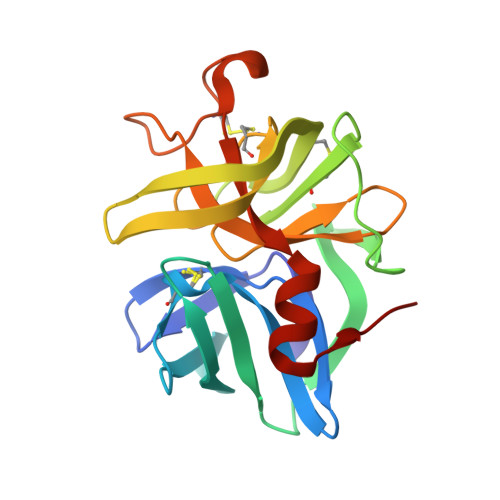The 0.83A Resolution Crystal Structure of alpha-Lytic Protease Reveals the Detailed Structure of the Active Site and Identifies a Source of Conformational Strain.
Fuhrmann, C.N., Kelch, B.A., Ota, N., Agard, D.A.(2004) J Mol Biology 338: 999-1013
- PubMed: 15111063
- DOI: https://doi.org/10.1016/j.jmb.2004.03.018
- Primary Citation of Related Structures:
1SSX - PubMed Abstract:
The crystal structure of the extracellular bacterial serine protease alpha-lytic protease (alphaLP) has been solved at 0.83 A resolution at pH 8. This ultra-high resolution structure allows accurate analysis of structural elements not possible with previous structures. Hydrogen atoms are visible, and confirm active-site hydrogen-bonding interactions expected for the apo enzyme. In particular, His57 N(delta1) participates in a normal hydrogen bond with Asp102 in the catalytic triad, with a hydrogen atom visible 0.83(+/-0.06)A from the His N(delta1). The catalytic Ser195 occupies two conformations, one corresponding to a population of His57 that is doubly protonated, the other to the singly protonated His57. Based on the occupancy of these conformations, the pKa of His57 is calculated to be approximately 8.8 when a sulfate ion occupies the active site. This 0.83 A structure has allowed critical analysis of geometric distortions within the structure. Interestingly, Phe228 is significantly distorted from planarity. The distortion of Phe228, buried in the core of the C-terminal domain, occurs at an estimated energetic cost of 4.1 kcal/mol. The conformational space for Phe228 is severely limited by the presence of Trp199, which prevents Phe228 from adopting the rotamer observed in many other chymotrypsin family members. In alphaLP, the only allowed rotamer leads to the deformation of Phe228 due to steric interactions with Thr181. We hypothesize that tight packing of co-evolved residues in this region, and the subsequent deformation of Phe228, contributes to the high cooperativity and large energetic barriers for folding and unfolding of alphaLP. The kinetic stability imparted by the large, cooperative unfolding barrier plays a critical role in extending the lifetime of the protease in its harsh environment.
Organizational Affiliation:
Howard Hughes Medical Institute and Department of Biochemistry and Biophysics, University of California, San Francisco, 600 16th Street, San Francisco, CA 94143-2240, USA.


















